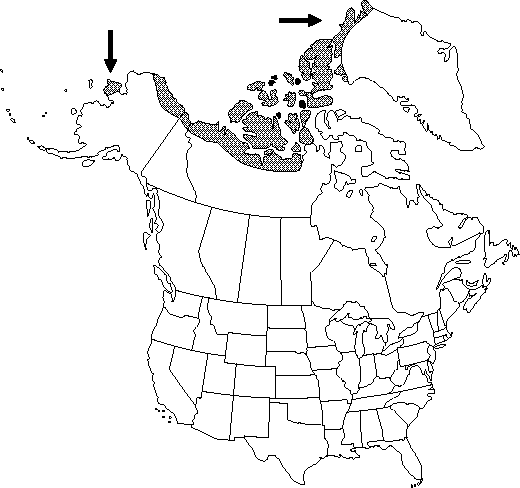Difference between revisions of "Ranunculus sabinei"
J. Voy. N.-W. Passage, Bot., 264. 1824.
FNA>Volume Importer |
GeoffLevin (talk | contribs) (Added Nunavut to distribution; treatment was published before Nunavut split from N.W.T.) |
||
| (8 intermediate revisions by 2 users not shown) | |||
| Line 13: | Line 13: | ||
|basionyms= | |basionyms= | ||
|synonyms={{Treatment/ID/Synonym | |synonyms={{Treatment/ID/Synonym | ||
| − | |name= | + | |name=Ranunculus pygmaeus subsp. sabinei |
|authority=(R. Brown) Hultén | |authority=(R. Brown) Hultén | ||
| + | |rank=subspecies | ||
}} | }} | ||
|hierarchy=Ranunculaceae;Ranunculus;Ranunculus subg. Ranunculus;Ranunculus sect. Epirotes;Ranunculus sabinei | |hierarchy=Ranunculaceae;Ranunculus;Ranunculus subg. Ranunculus;Ranunculus sect. Epirotes;Ranunculus sabinei | ||
| Line 23: | Line 24: | ||
}}<!-- | }}<!-- | ||
| − | --><span class="statement" id="st- | + | --><span class="statement" id="st-undefined" data-properties=""><b>Stems </b>erect or decumbent, 1-12 cm, sparsely pilose, each with 1-3 flowers. <b>Roots</b> slender, 0.3-0.8 mm thick. <b>Basal</b> leaves persistent, blades broadly obovate to transversely elliptic, 3-lobed or -parted, 0.9-3 × 0.8-3.4 cm, segments undivided or again lobed, base obtuse, margins entire, apices of segments rounded to rounded-obtuse. <b>Flowers</b>: pedicels pilose; receptacle pilose; sepals 4-7 × 2-3 mm, abaxially pilose, hairs colorless; petals 5, 5-8 × 3-4 mm; nectary scale glabrous. <b>Heads</b> of achenes cylindric, 6-9 × 4 mm; achenes 1.2-1.4 × 0.8-1 mm, glabrous; beak lance-subulate, straight or curved, 0.4-0.6 mm. <b>2n</b> = 64.</span><!-- |
-->{{Treatment/Body | -->{{Treatment/Body | ||
| Line 29: | Line 30: | ||
|habitat=Slopes and hummocks in tundra, in sandy or gravelly soil | |habitat=Slopes and hummocks in tundra, in sandy or gravelly soil | ||
|elevation=0 m | |elevation=0 m | ||
| − | |distribution=Greenland;N.W.T.;Yukon;Alaska. | + | |distribution=Greenland;N.W.T.;Nunavut;Yukon;Alaska. |
| − | |discussion=<p>An alternative interpretation of this taxon is given by E. Hultén (1971) who considered it to be the hybrid Ranunculus nivalis × R. pygmaeus, and considered all specimens referable here to be hybrids or members of stabilized populations of hybrid origin.</p> | + | |discussion=<p>An alternative interpretation of this taxon is given by E. Hultén (1971) who considered it to be the hybrid <i>Ranunculus nivalis</i> × <i>R. pygmaeus</i>, and considered all specimens referable here to be hybrids or members of stabilized populations of hybrid origin.</p> |
|tables= | |tables= | ||
|references= | |references= | ||
| Line 39: | Line 40: | ||
-->{{#Taxon: | -->{{#Taxon: | ||
name=Ranunculus sabinei | name=Ranunculus sabinei | ||
| − | |||
|authority=R. Brown | |authority=R. Brown | ||
|rank=species | |rank=species | ||
|parent rank=section | |parent rank=section | ||
| − | |synonyms= | + | |synonyms=Ranunculus pygmaeus subsp. sabinei |
|basionyms= | |basionyms= | ||
|family=Ranunculaceae | |family=Ranunculaceae | ||
| Line 49: | Line 49: | ||
|habitat=Slopes and hummocks in tundra, in sandy or gravelly soil | |habitat=Slopes and hummocks in tundra, in sandy or gravelly soil | ||
|elevation=0 m | |elevation=0 m | ||
| − | |distribution=Greenland;N.W.T.;Yukon;Alaska. | + | |distribution=Greenland;N.W.T.;Nunavut;Yukon;Alaska. |
|reference=None | |reference=None | ||
|publication title=J. Voy. N.-W. Passage, Bot., | |publication title=J. Voy. N.-W. Passage, Bot., | ||
|publication year=1824 | |publication year=1824 | ||
|special status=Endemic | |special status=Endemic | ||
| − | |source xml=https:// | + | |source xml=https://bitbucket.org/aafc-mbb/fna-data-curation/src/2e0870ddd59836b60bcf96646a41e87ea5a5943a/coarse_grained_fna_xml/V3/V3_649.xml |
|genus=Ranunculus | |genus=Ranunculus | ||
|subgenus=Ranunculus subg. Ranunculus | |subgenus=Ranunculus subg. Ranunculus | ||
|section=Ranunculus sect. Epirotes | |section=Ranunculus sect. Epirotes | ||
|species=Ranunculus sabinei | |species=Ranunculus sabinei | ||
| − | |||
| − | |||
| − | |||
| − | |||
| − | |||
| − | |||
| − | |||
| − | |||
| − | |||
| − | |||
| − | |||
| − | |||
| − | |||
| − | |||
| − | |||
| − | |||
| − | |||
| − | |||
| − | |||
| − | |||
| − | |||
| − | |||
| − | |||
| − | |||
| − | |||
| − | |||
| − | |||
| − | |||
| − | |||
| − | |||
| − | |||
| − | |||
| − | |||
| − | |||
| − | |||
}}<!-- | }}<!-- | ||
-->[[Category:Treatment]][[Category:Ranunculus sect. Epirotes]] | -->[[Category:Treatment]][[Category:Ranunculus sect. Epirotes]] | ||
Latest revision as of 17:14, 24 September 2021
Stems erect or decumbent, 1-12 cm, sparsely pilose, each with 1-3 flowers. Roots slender, 0.3-0.8 mm thick. Basal leaves persistent, blades broadly obovate to transversely elliptic, 3-lobed or -parted, 0.9-3 × 0.8-3.4 cm, segments undivided or again lobed, base obtuse, margins entire, apices of segments rounded to rounded-obtuse. Flowers: pedicels pilose; receptacle pilose; sepals 4-7 × 2-3 mm, abaxially pilose, hairs colorless; petals 5, 5-8 × 3-4 mm; nectary scale glabrous. Heads of achenes cylindric, 6-9 × 4 mm; achenes 1.2-1.4 × 0.8-1 mm, glabrous; beak lance-subulate, straight or curved, 0.4-0.6 mm. 2n = 64.
Phenology: Flowering summer (Jul–Aug).
Habitat: Slopes and hummocks in tundra, in sandy or gravelly soil
Elevation: 0 m
Distribution

Greenland, N.W.T., Nunavut, Yukon, Alaska.
Discussion
An alternative interpretation of this taxon is given by E. Hultén (1971) who considered it to be the hybrid Ranunculus nivalis × R. pygmaeus, and considered all specimens referable here to be hybrids or members of stabilized populations of hybrid origin.
Selected References
None.